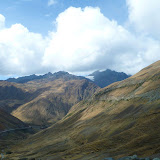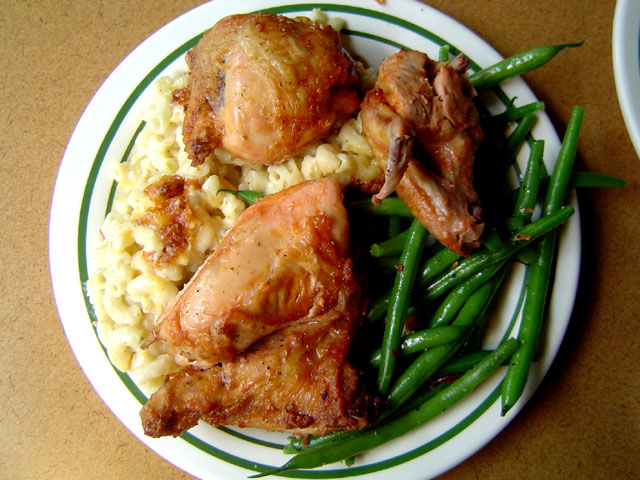|
|
|
|
|---|
Senin, 30 Agustus 2010
Minggu, 29 Agustus 2010
Kamis, 26 Agustus 2010
At Play in Xi'an's Arcades

Street Fighter II is still available and still played in Xi’an’s videogame arcades. During the past month, me and a few other (male) teachers at my school became obsessed with playing arcade games on our breaks from class. It was here we rediscovered the magic of our old favorites and the charms of many new ones.
Videogames are a sort of art. They may lack the emotional heft of an ambitious movie or book, but compared to Iron Man or the latest Clive Cussler novel, they hold up well. Consider one shooting game in particular wherein you and a partner play X-Files-style agents investigating a haunted museum: It starts simply enough with a few mummies popping up here and there, old Greek amphora flying toward you. Then the mummies increase, then you are surrounded, then totem poles begin lobbing pumpkin-things at you, then you are flying through a mining tunnel, then you are being swarmed by bees, then you are being chased by the Sphinx. . . .the entire game has the quality of a fever dream and it’s a thoroughly entertaining experience.
There are two major arcades along Luomashi—the pedestrian promenade near Walmart—and, if shooting mummies or pummeling a multinational cast of characters isn’t your thing, there are a multitude of other options. The major draws seem to be a game where four unallied players sit around a large table-cum-tv-screen and shoot at fish. There doesn’t seem to be much more to it than that and yet it draws crowds. In addition to the players—mostly men in their twenties and thirties—there are girl-friends and large numbers of unconnected spectators.
Of the two arcades, Tom’s World is the more varied and enjoyable. Its crowd is much younger: Parents with small children, groups of young kids, and teenagers on dates all mill about. In addition to the games mentioned, it has basketball tossing games, whack-a-mole games, drum sets, Dance-Dance Revolution, skee-ball, claw crane games, and many other fun-for-all-ages games. All games require tokens and cost about 1 yuan per game—a few more complicated games cost 1.5 yuan.
The other arcade Can Lan Yang Guang (whose mouthful of a name translates to something like Happy Sunshine Fun City) is less kid friendly. It’s darker and dingier with less variety of games. Whereas Tom’s World is all bright tones and high ceilings, this place resembles a series of underground tunnels. Colors are black and muted. People are packed together at close quarters. The crowd is older—no children on the day I visited. Instead it there is an abundance of older boys with sparse growths of mustache and girls caked in make up. I made my way through the place feeling as though I might stumble into a back room with a Russian roulette game in progress of be greeted by a tout offering to sell me drugs or endangered animals. Overall, a less wholesome feel.
Clearly, my sympathies lie with Tom’s World and, during the past week, a number of my work breaks have been filled with visits. Typically I settle in at the Street Fighter IV game only to be repeatedly out-matched by a series of small children who take turns at beating me, their laowei compatriot.
The only downside of these places are the slot machine style games whereat lonely, stone faced men and women plop in coin after coin. Just like pull tabs in a bar or the Las Vegas casinos, these games seem a bit dreary and dispiriting. Avoid them, however, seek out the bright colors of other games, and you will find yourself re- experiencing a little of the youthful pleasure such places once provided.
Rabu, 25 Agustus 2010
Kamis, 19 Agustus 2010
it's yours.
Senin, 16 Agustus 2010
Kashgar

“I hate the Han, I hate the way they treat the Uighurs. They’re colonizing them. I’m so glad that I’m living in Urumqi—not “Wulumuqi”—I have all Uighur students. They’re much kinder, much friendlier. Han are rude. They spit, they cheat you. They don’t care about culture.”
The German said all this to me as we waited for our noodles. He was—perhaps unsurprisingly—tall, blond, clean-cut, and impeccably well spoken in English. We’d met at the hostel and were going over the details of an impending trip to the mountains. He’d been living in China for ten months now (two in Urumqi) studying on a scholarship. He was fantastic in speaking Chinese and Uighur and was passionate about the latter. His jeremiads against the Han struck me as extreme; his ability to zealously commit made me feel old. I felt inklings, stirrings of what he was getting at, but nothing sparked such partisanship in me.
“Well,” I put in, “I have to agree about culture. I came to China to experience the culture. I didn’t expect things to be the same now as one hundred years ago, but I also didn’t expect to see . . .well, no culture. And, because they don’t seem to care for their own culture, they have very little respect for other’s cultures. My students know little and care little about minority peoples.”
“Yes! And here you see so much culture. You feel it. I always try to use uyghurce when I speak. It’s a sign of respect. But the Han—the fucking Han—they don’t even try to learn. They don’t mix . . .”
Imperialism With Chinese Characteristics

Every large country—and most small countries—have sizeable numbers of people who exist at a remove from the national culture. Northern Canada is an Inuit autonomous zone, swaths of Russia’s southern regions are divided among various minority peoples, Brazil’s Amazon region is awash with diverse tribal groups, and the US has hundreds of reservation lands governed by special laws; even somewhere like Mexico that lacks such special regions is full of minority peoples speaking their own languages and raising their children up in cultures distinctly separate from that seen on tv and in the halls of power. And most, if not all, of these groups suffer from abuse of their human rights.
My German’s views were nothing special. Every minority has its outside spokespeople—academics and activists—who champion the uniqueness of the culture and castigate the oppressive state that rules over it. When it comes to China, Tibet gets most of the attention. In the US, it’s fashionable to sport “Free Tibet” t-shirts and stickers, but the realities of the situation, both there in Xinjiang, seem muddier: Small, weak countries with no access the sea, small populations, limited water-supplies, and huge powerful neighbors are rarely fully independent. Were a place like Xinjiang free tomorrow, it would become just another zone where the US, Russia, China, and Pakistan compete for influence. One minority group would be pitted against another. Regions with the most resources would receive money and attention. Regions with nothing would be ignored.
What China provides is stability. It builds roads and electrical grids, it establishes bank branches and doles out credit to rural areas. East coast money flows in to fund massive mining and oil ventures that offer jobs where no jobs had been. By incorporating Xinjiang in a national market it creates more opportunities for local farmers to sell their produce. Through infrastructure and security, it encourages tourism.
That’s on the one hand. With Chinese money, however, flows Chinese people. Millions. Business in China is all about connections—friends getting jobs for friends, cousins looking out for cousins. (As the saying goes, when a man becomes emperor, even his pets become ministers.) This isn’t conducive to promoting minority involvement. Newly created jobs go to Chinese. Government policies to boost wages in the region encourage settlement by Han.
A thousand years ago, deserts meant something. The Silk Road was nothing but oasis towns and wilderness connecting the Chinese in the east to Central Asia in the west. Now half the population of Xinjiang is Han Chinese—mostly concentrated in the eastern half, centered on the capital of Urumqi. The traditional names of Silk Road towns—Kashgar, Yarkand, Hotan—are unknown to Chinese who have renamed them—Kashi, Sanche, and Heitan, respectively. Thousands of years of culture is disappearing.
I’ve met a good number of Chinese by now, mostly twenty-somethings, who were born and raised in Xinjiang. By and large they have no interaction with the Uighurs; they might know how to count numbers and say “Hi,” but little else. Many are unaware of the traditional names of cities they live in.
I spent most of my time in the Uighur part of Kashgar, but it was clear that the People’s Park represents the dividing line between populations. The park is full of old Chinese doing precisely the same activities you would see in Xi’an—singing, strumming instruments, playing cards, doing various exercises. Further south the businesses and restaurants become more recognizably Chinese. The architecture is newer and the buildings—shopping malls and banks—hint at East coast money and aesthetics. In the morning, you see restaurant staffs gathered together for their morning pep-talks. There is suddenly more public spitting and urination. At night there is line-dancing and basketball. All those involved are Han, any Uighurs visible stand off to the side and watch. Policemen and soldiers patrol. You are wholly back in China.
And the locals don’t like it. There have been sporadic uprisings over the years and last year, in 2009, the most major in a generation occurred. Large-scale rioting broke out in Urumqi with gangs of Uighurs spilling out from the city’s shanty-towns and attacking Chinese. In the following week a series of pokings and stabbings led to rumors of Uighurs roaming the city, injecting Han with AIDS-laced hypodermics. Han began organizing vigilante groups to mete out vengeance in the Uighur parts of the city. The army was sent in and the city put on curfew. Facebook—thought to be used in the organizing—was banned in China.
Powerful states like the US or China seek to impose order on their territories and (if possible) on the world. Many of the problems states face is that the world is not always as they would like and many peoples do not want their lives altered so that some outside culture can “make sense” of them. Xinjiang presents China with this problem.
A thousand years ago there were “Uighurs.” They were one of many different groups (and, really, their history can be traced back twice as far), but as to what being a “Uighur” truly means in modern China, the question is more vague. The range of faces and styles is vast, suggesting that the category is rather broad—the music, the food, and the dress are all a mix of different Central Asian traditions. The only true commonality is the language, and even this has regional variations—perhaps because many other minority groups in the region, like Tajiks, use the language as a lingua franca. But the Uighur spoken today is hardly the Uighur spoken in the 11th century.
The quest for what is authentically “Uighur” is a mirage. China claims to have dominated the region for centuries, Uighurs can point back to an ancient kingdom of their own and various periods of fleeting independence in the last century, but it’s all posturing. The connection between past and present is mutable. Much of the world is an endlessly mixing hodgepodge of tribal groupings. One group intermingles with another and becomes something new. Time passes, but the location remains the same. In the end, there is but one irreducible fact as the Uighurs see it: They are from here, the Chinese are not.
Thus, for all these signs of having dug in, there is a sense among the Han of being deep in Indian Country, of holding down the fort, of pacifying the land. It’s very uncomfortable to watch one people slowly drown out another people, but it would be foolhardy to think the process unique or even particularly bad compared to how other empires have gone about it.
Uighur Culture

In the last year, the central government has poured large amounts of money into the region and talked up its attempts to improve the economy. I flew into the city on the one year anniversary of the riots and it is no coincidence that the day’s China Daily contained a front page article discussing efforts to make Kaghar into a special economic zone, complete with quotes from approving locals.
The most apparent manifestation of this largesse, however, is the nearly complete destruction of Kashgar’s old city. Old, Islamic style building have been torn down and are set to be replaced by new apartment blocks which the government promises to construct using traditional architectural motifs. In the meantime, though, there is nothing but dusty rubble and scattered ruins. The impression is creates is of Grozny more than the Silk Road.
Such destruction from on high has not sat well with locals and on Friday, watching the crowds—hundreds upon hundreds of utterly unChinese faces—flow into the Id Kah mosque for prayer, I was reminded of how much the government fears gatherings. For centuries, leaders throughout the Middle East and Central Asia have been wary of the mosque and the marketplace. Men come together as one to pray and trade; they complain, they talk, they surge. Revolutions start here. Yet such resistance will likely produce diminishing returns.
What then is this culture that is passing away, whittled down, marginalized into nothingness?
As I’d explained to the German, I’d come to see “culture,” so I wish I could give more details—more local flavor—but I was hardly here long enough. I didn’t go to weddings or parties or visit people’s houses. Mostly I did a lot of walking, looking, listening and tasting. Much of my time was spent at little street restaurants chatting pidgin with cooks, wandering along the street, or making my way through parks and markets.
Generally, I was reminded of Turkey—well, the poorer parts of Turkey. The rhythms of speech, many of the faces, and the gestures were largely similar. Even the advertising was similar: Towering over the central square was a billboard for Ulker, a major Turkish candy company. Stores selling suits had display images featuring cast members from Kurtlar Vadesi, the Turkish mafia soap opera.
Woman dressed in the more colorful versions of the moderate Muslim style (long dresses or coats and colorful headscarves), but some covered their faces with purple-mesh, or wore heavy, brown coverings over their entire bodies. The men typically wore slacks and white shirts; usually a little hat sat a top their heads. Overall, the street life had a far more masculine flavor than in China. Women were present, but men, large groups of them, gathered together in the squares, on the streets, looking down from second-floor café balconies, and in front of shops.
The people I saw also seemed older. There were far less twenty-somethings out and about. Whether this was because they were at work, in school, or had migrated to larger cities, I can’t say. At the city’s main bookstore, I struck up a conversation with one young Uigher. He had just finished university in Korla and was now preparing to take a civil service exam. Most of our conversations revolved around salaries, electronics, and the promise of life in America. The picture he painted of Kashgar was less than enthusiastic. Opportunities were lacking.
Such chats aside, my main focus tended to be the food—something whose experience language gaps cannot diminish. Uighur food could be fairly summed up as meat and bread. It wouldn’t be totally fair, but it would be largely true. Kebabs are the heart of the Uighur cuisine and Lord are they good! Fat chunks of meat soaked and coated in a spiced-egg marinade are wood-oven baked. The result is a smoky-flavored meat with a light, crispy crust. The meat itself is juicy and flavorful; always four pieces per skewer, a combination of fat, liver, and two standard cuts.
As for bread, Uighurs produce, large disks of bread with raised edges resembling empty pizza crusts. On the flat circle are stamped and intricate designs. Sprinkled over the bread for flavor are a variety of spices—the most prominent ones being sesame seeds and thyme. Every street seems to have at least one—if not multiple—vendors. Also offered are bagel-shaped (and bagel flavored) rounds of bread that, since vendors had no ready name, I will refer to as “bagels.”
Side by side with the bread vendors are fruit vendors. Everywhere you turn there are carts and stands overflowing with fruits. The region has some of the freshest, tastiest melons I have ever eaten. A few would be recognizable in any western supermarket, but the variety extends far wider to encompass all hues and textures. Small crowds gather around, waiting for their turn as vendors dexterously carve up and hand out slices.
Off the street entrees include noodle dishes. The most famous—the one I’d learned to say on day one of my Uighur language classes in university—was laghman. This is a combination of green peppers, mutton, tomato, and onions, poured over noodles. It’s simple and satisfying. More intimidating is dapanji, a dish of spicy chicken chunks and potatoes. Rather than rice, one mixes long, flat noodles into the dish. Small game hens are also very popular. Fish, though troublingly far from any major river and ocean, is also available in battered and fried (but not de-boned!) form.
Uighur food is a mélange of different, regional cuisines. On one street, I came across a vendor selling poruska, egg rolls covered in raw sugar and filled with fatty meat and onions. The combination—to my palate—worked as well as it sounds, but the obvious Russian influence intrigued me. (Sure enough Xinjiang has long been an area for Chinese-Russian competition and the areas around the Ili Valley have modest Russian populations.)
Other borrowings include samsas—bread filled with meats and other stuffings before being oven baked—and pollao, fried rice cooked with onions, carrots, and cumin.
For drinks, a version of tea, slightly stronger than Chinese varieties is the standard, but milk too is plentiful in Kashgar. Little stands sell it by the glass and, at night, ice-cream vendors set up here and there, portioning-out fresh-made cups. In the countryside the milk is fresh and un-pasteurized—outside the city, my tea was repeatedly softened with yak’s milk.
And, during my trip, I drank a lot of yak’s milk . . .
Outside the City

Living among Han Chinese, it’s easy to forget that the People’s Republic of China is a “multi-ethnic state” with more than fifty different minority peoples “fairly” represented. It’s necessary to visit the areas where these people live to be reminded. Tourist site after site contains informational plaques attesting to the multi-ethnic character of the state and recounting the conscientious steps the Party has taken to improve or promote buildings and sites of particular importance to minority groups. The feeling such a heavy-handed message produces, of course, is the opposite—constantly shouting how stable a society is tends to the best indication something is amiss.
Going outside Kashgar, along the Karakorum Highway towards the Pakistani border, gave a very good sense of how minority life is lived in China. The region is populated by Kirghiz and Tajiks. The former are more Asian-looking while the latter, as the pattern of their speech would suggest, as more Persian. Both peoples tend to live in yurts and both have faces reddened by high altitude wind and sun. Clothing-wise people—especially far away from population centers—wear combinations of the traditional and the modern. One man will be wearing a peaked, white Kirghiz hat while his friend’s head is shielded by a baseball cap marked with a Japanese-designer’s name.
Along the roads, Kirghiz wait for passing cars to stop whereupon groups of men and children swarm. Most commonly on offer are little, polished, translucent stones that glow orange and green when held to the light. None speak much Chinese or Uighur. Their world is concentrated around their mountain valleys. In a country where social mobility is largely a product of success on the national gaokao test (administered in Chinese) the chance of escaping one’s conditions is less than hopeful.
Tajiks seemed more urbanized in so far as they concentrated around the “city” of Tashkurgan. Here arid mountain landscapes give way to a verdant expanse of valley with the town in its center. The fields around it are dotted with yurts, lowing cows, and the smoke from small fires.
In the town we—the Uighur-phile German, a Frenchman, and myself—wandered around in search of diversion. There was little. The city center consisted of three or four streets lined with dusty stores offering clothes, snacks, or farming supplies. A couple of hotels, a bar, and a pair of restaurants—little else. The most imposing building in the town (aside from police and military installations) was the local cultural center and museum. We headed over to it and entered into a small lobby where two men were busily playing a game of ping-pong.
One of the men, Kaftan, could speak English. He had studied in Beijing and now worked as the local union representative for the city. There were, he explained, something like sixty different unions in this small town. By “unions” he meant something similar to “work units”—every worker in a particular job banded together for the purpose of government oversight. He was clearly bored with the opportunities his town had to afford and peppered us with questions about how he might start a tourism business.
By nightfall the street were empty—the only noise coming from a single bar and the occasional moo from the field.
We’d chosen to stay in the cheaper of two hotels near the entrance to town. Our hotel had a main building where tour groups stayed, its concierge desk manned by an attractive Han girl with whom me and the Frenchman flirted. Our room, however, was in a newly constructed, two-story plasterboard building adjacent. The whole place smelled like cigarettes and the desk was managed by a middle age Han man with a large mole on his cheek.
That night we lay around watching Germany lose in the World Cup. The following day we visited Karakol Lake. The three of us made it halfway up a little mountain before the German grew tired and decided to head back down. He’d been grousing all day about various unanticipated inconveniences the trip had thrown in our path and, needing a break from complaints, I opted to remain where I was. The Frenchman kept going all the way up, until he was nothing more than a dot on the peak of the mountain. The wind at this altitude hit into you like fists. I found a rock that blocked me from the worst of the buffeting and gazed up at the deep blue sky above. Even from my halfway vantage, I could see the entire valley and it’s surrounding mountains spread out around me.
Some travels give you the illusion that you are venturing into untouched lands where people have seldom been; traveling into the mountains of Asia, you go were people never seem to have left. The lake below was dotted by yurts and I was overcome with the knowledge that, a thousand years ago, there had been others standing in the same place.
Not that life is static: Electrical wires run along the roads bringing power to people ensconced deep in the mountains; cars, trucks, and motorcycles bring supplies rapidly. But even directly along the roads-sides, where access to commerce is easy, life remains harsh. People live scattered in small brick houses, sheltered from the harsh winds of the open plateau. The densely packed Chinese east seems like a dream.
(Photo essays available HERE)
Minggu, 15 Agustus 2010
Jumat, 13 Agustus 2010
Selasa, 10 Agustus 2010
The Jungle Book, "Gastronomy"
Fried fish bits and yuca. Yuca is a delicious potato like plant. Especially good when fried.
More fried fish bits with beans and rice. They grow a lot of rice on the slopes near the river.
Fried sweet banana and maracuya juice. Tastes like dessert!
Fried banana slices...the Amazonian french fries. Healthier? I doubt it.
Bananas, bananas, and more bananas. Most dishes include bananas...cause they are freaking everywhere!
Caña or sugar cane. You chew it, drink the juice, then spit it out. They make a strong alcohol out of this as well.
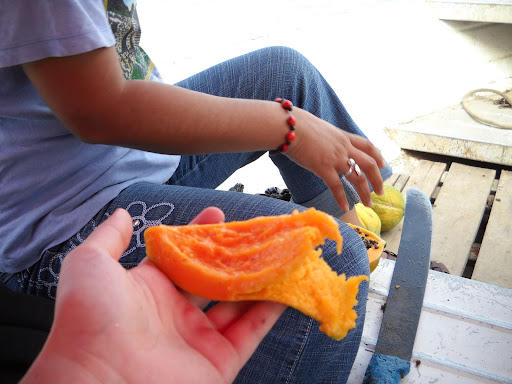
Tons and tons of fresh fruit! Pick it and cut it open with your machete.
Tortuga...turtle. This one is still alive, but it will make a great soup. The people also like boiled tortuga eggs.
The Jungle Book, "Belén"
I have been very busy travelling and wrapping up my project so my The Jungle Book series has fallen behind. Reminder: I visited the jungle with org Minga Peru (see previous Jungle Book posts) from July 22 to 25 to learn more about their work empowering indigenous women living in rural communities.
On July 25th (last day in Iquitos), Emira, Cesar, and I visited the market and community of Belén, an extremely poor district on the shores of the city's eastern river. Unfortunately, I did not get any pictures of the market; although, its sights and smells will be forever imprinted in my brain. The market is immense! It stretches on forever...stand after stand of meat, potatoes, fruit, vegetables, pots and pans, artisanry, and lots and lots of fish. Every shape, color, and smell of fish could be found in that market, guarded from the flies and vultures by swatting children. The streets of the market (and the barrio) were covered in trash...rotten vegetables, the insides of animals, bottles, rags, paper, shoes...everything. Vultures preyed on the piles weaving through the hundreds and hundreds of people perusing (ha!) the merchandise.
Emira and Cesar were particularly excited to show me a specific alley way in the market where vendors sold natural medicines from the jungle. Bottles of unknown liquids, baskets of bark and fish fins, bags of ground powders, and big piles of (what I hoped were) odd looking mushrooms covered every square inch of the wooden tables. Upon approaching a table, someone would immediately ask "What ails you?"
The actual residential area of Belén was a mess. The barrio is on the shore of a large river that floods the street for three months every year. The waters wash in tons and tons of trash. Mountains of trash. During the dry season trash fills every spare corner. Children kick mounds away to make room for their games.
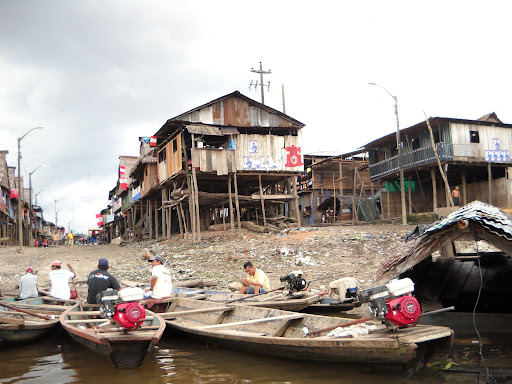
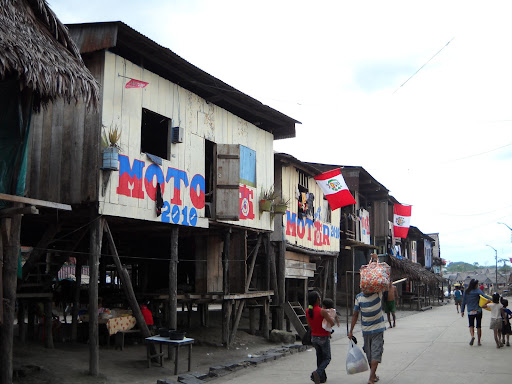
Because the river rises so high every year, the homes are build very high off the ground. Those immediately next to the water are built to float. As the water rises, so do the homes. Families can float their homes down river if they wish to.
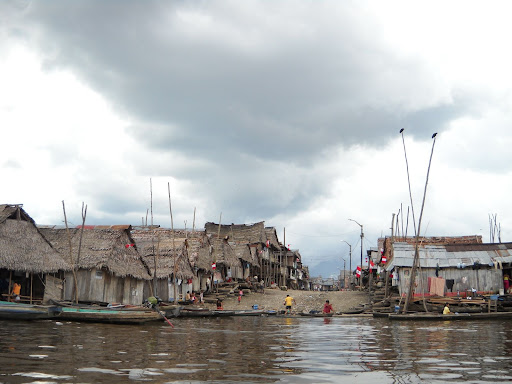
We visited the community to meet and talk with Jose, a coorespondent for Minga's radio programs. We sat with him underneath his house and taked about the social projects and the needs of Belén. Jose emphasized the issue of alcoholism specifically among young men. He also mentioned several failed attempts by other orgs to rid the neighborhood of its unsanitary man made mountains.
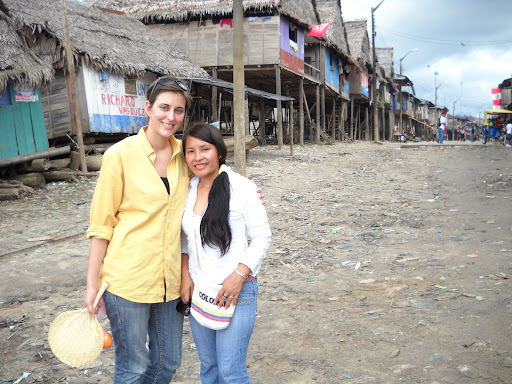
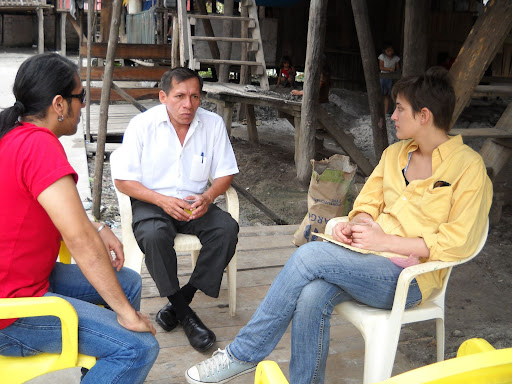
He praised Minga's work in the community especially the radio programs' focus on alcohol and drug abuse. He expressed that Minga's particular "intercultural" approach to the issue reached the young people in a unique and effective way.
Senin, 09 Agustus 2010
PERUsing the Andes Mountains + Machupicchu!
Originally, I planned for an extra week in Peru to do said trekking and travelling; however, it turned out that Peruvians take several days off of work for their Independence Day. Thus, the extra week. I flew from Lima to Cusco (the ancient capitol of the Incan Empire) on July 29th and returned yesterday (August 8th). From August 3rd to the 7th, my roommate, Annie, and I trekked from Cusco to Machupicchu with a trekking agency (and 9 other tourists).
Cusco is almost 4,000 meters above sea level (over 13,000 feet or 2.5 miles). Por eso, many tourists get altitude sickness or "soroche." Unfortunately, I came down with a particularly annoying case. I don't have any fact to support my suppositions, but I imagine that when you arrive at high altitudes the pressure inside your body is greater than the pressure outside. So, it feels as if you are expanding. Your sinuses act up, you have a headache, nausea, aching, weakness, and vertigo. Not pleasant. I was only in bed for the first day. The three days after I felt a bit "off" but moved around all the same.
Cusco, Peru
Cusco was the Incan capitol in the 1500s when the Spaniards arrived and claimed the city as their own. Therefore, the city is very colonial with European cobblestone streets and towering cathedrals.
These cathedrals are in the main square and were constructed in the 16th and 17th Centuries.
Cuy and cerdo...guinea pig and roasted pig...big favorites in the Andes region.
The top picture is me with a can of oxygen. There is a lot less oxygen in Cusco which was difficult for me. I carried this thing around with me for about four days.
Saqusawaman
On July 30th, I hiked up to a set of ruins high above Cusco. These ruins were once an impressive Incan military fortress. Manco Inca, the last Incan ruler, fought the Spaniards from this point in an epic and history-altering battle. Obviously, the Incans lost.
Later the Spaniards took several of the stones from this fortress to build their cathedrals in Cusco's Plaza de Armas.
Pisaq
Annie and I took one full day to hike up to the ruins at Pisaq. The village of Pisaq is about an hour and a half outside of Cusco. High above the pueblo sits an extensive system of ruins that took about 5 hours to explore. It constituted another Incan fortress. The Spaniards did not do much with this particular site, because it is so difficult to get to. We hiked for a good hour and a half panting our way to the top.
The hike was straight up!
However, definetly worth the effort.
The hike was just gorgeous!
But we were exhausted once we got to the top.
White Water Rafting on the Urubamba River (sacred river of the Incas)
Another full day trip was our white water rafting adventure. Annie and I booked a tour with an agency and spent a very cold but very thrilling two hours braving level 3 rapids.
We had to wear wet suits, windbreakers, life jackets, and helmets.
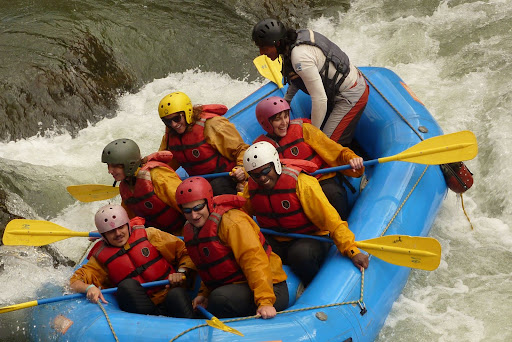
Trekking
Annie and I signed up for a 4 day hiking excursion from Cusco to Machupicchu.
Day 1: We began by biking for 4 hours from 4,000 meters above sea level to 1,200 meters. We began the trip at almost freezing temperatures. We ended in the selva alta (high jungle). By the end we were down to our last layers and swatting at thousands of mosquitos (I have about 30 bug bits on my hands and arms).
Day 2: Beginning at 7:30 am, we trekked through the mountains, the valleys, and the jungle for 9 hours. In that span of time, I felt as if I had visited the landscapes of Arkansas, Montana, Colorado, North Carolina, and Hawaii. Our guide said that Peru is home to 80 different types of climates.
Our guides painted our faces with the fruits of a typical plant found in la selva alta (high jungle).
We stopped at a rest area to play with a monkey and get some water.
We emerged from the jungle and hiked to the top of a nearby mountain.
This was part of our trail.
At the end of the day, we rested in a natural hot spring before going to bed.
Day 3: Hiked for about 6 hours to Aguas Calientes, the tourist watering hole at the bottom of Machupicchu.
We crossed the river via a "cable car" or a basket suspended above the water and rope to pull yourself along.
We slept in Aguas Calientes, a small town at the base of Machupicchu mountain that hosts 2,000 tourists a day (in comparison to the 800 actual residents).
Day 4: MACHUPICCHU!
We got up at 3:30 am to hike up Machupicchu mountain. It was pitch black. Our group of 11 along with almost 400 other people trekked up the side of the mountain in a dense line. The trek was straight up a set of original Incan stairs. An hour after beginning, we arrived at the top drenched with sweat.
And this is what sat at the top! After a 2 and a half hour tour, Annie and I hiked all over those mountain tops. We spent about seven hours hiking in and around the "lost city of the Incas." We visited the Sun Gate ("intipunku" in Quechua) about 45 up the mountain behind the city and an ancient Incan bridge built into the side of Machupicchu mountain. The ruins of Machupicchu are perfectly preserved, because the Spanish never found the city (due to it's geographically impossible location). Historians hypothesize that the city was used to house "Virgins of the Sun," women who spent their entire lives serving the sun god (unless they had the great honor to be sacrificed).*
The Sun Gate.
The Incan Bridge.
On August 7th, we took a train/bus from Aguas Calientes back to Cusco.
I wish I could convey the absolute wonder of the Andean region and everything that I saw. You can feel the powerful force of nature all around you. The mountains rise high above you on all sides making you feel vulnerable and protected all at once. The Andean people believe that there are "apus" or gods in the mountains. I can certainly see why. From the animals to the landscape to the people, there is a sense of wonder and spirituality that, I can only imagine, comes from living in such a awe-inspiring place.
As far as the remains of the Incan empire, specifically Machupicchu (one of the seven wonders of the world)...there is nothing like it. It meets the highest expectations. There is nothing like standing above the ancient city, a drop of several thousand feet on your right, a massive 600 year-old wall on your left, and a vista of green mountains topped with glaciers stretching to the horizon. I am so grateful to have had this wonderful experience.
*I took so many pictures of Machupicchu, because every corner holds something wonderful and fascinating. The link below is my picasa album with my many photos.
